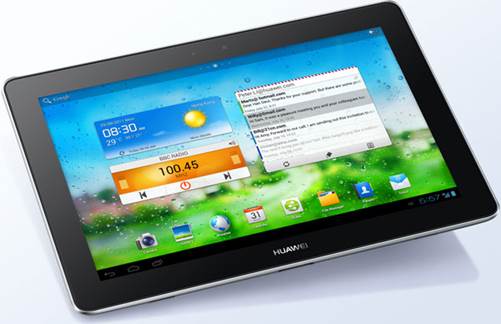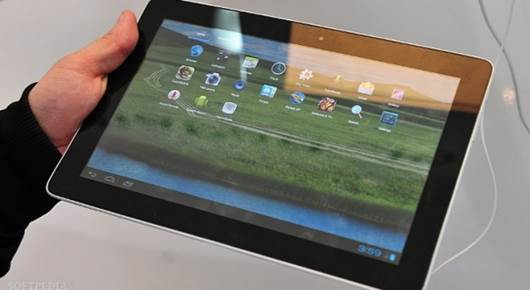Huawei MediaPad 10 that is the Company’s
first 10-inch tablet was tested.
Until the end of Huawei’s Mobile World Congress
press event last February, the company leaders made a brief mention of a
upcoming 10-inch, quad-core tablet. With the media in attendance, it was an
overview of the best case and a dangling hardware "carrot", there was
no doubt. At the same time, the company made the curious journalists move
away, but confirmed some high-end specs: a 1,920x1,200 IPS screen, 8MP rear
camera, LTE (Cat 4) / DC-HSPA + radios and exclusive quad-core CPU K3V2
supported by 2GB of RAM. It would not be until 3 months later at CTIA in New Orleans;
we would probably put our hands on the device.

The
company confirmed some high-end specs of the MediaPad 10: a 1920x1200 IPS
screen, 8MP rear camera, LTE (Cat 4) / DC-HSPA + radios and exclusive quad-core
CPU K3V2 supported by 2GB of RAM
MediaPad 10 was released in Europe, many of
the rumors largely disappeared after a wave of the high-end product launches
(think about the Nexus 10 using Google’s Retina or the new iPad). But is there
any reason to give the MediaPad 10 a second look at?
Hardware

Framing
the Gorilla Glass screen is a large bezel with the front-facing camera on the
top and the Huawei’s company logo at the bottom.
Last November, Huawei brought the 7-inch
MediaPad to the United States, where it went under an alias that is T-Mobile
Springboard. After all, it was a tablet that we quite liked - not just because
the hardware was well made. Now, as the first 10-inch tablet is released,
Huawei is borrowing several important design elements - namely, the mix of
white plastic and chrome. The MediaPad 10 does not totally replicate the
backside of the original model; instead of that, it chooses a single white
strip that extends across the metal back. Located in the middle of that strip
is the 8MP camera; as well as a closed slot for microSD and SIM cards (SIM
access is blocked on this Wi-Fi only model). Below those two slots, you'll find
the dual speaker setup, with one speaker on the right and the other on the
left. Even Huawei’s logo fades into the monochromatic coating.
Turn it to the front and it looks like
nearly every other 10- inch tablet, except whatever Sony has released. Framing
the Gorilla Glass screen is a large bezel with the front-facing camera on the
top and the Huawei’s company logo at the bottom. A 3.5mm headphone jack is on
the left corner, while the power and volume buttons are located on the opposite
side. Along the bottom, you'll find an exclusive charging port between two
V-shaped notches for the optional keyboard dock. Under the lid, the MediaPad 10
packs a 6600mAh battery and 16GB of storage, although it is also available in
8GB and 32GB versions. Regardless of which model you choose, the microSD slot
supports the memory cards up to 32GB.
While other tablet manufacturers have
blundered with the bulky designs, Huawei has scored a direct hit with the
MediaPad 10. With a thickness of 8.8mm, the 257x176mm tablet is thinner than
high-end rivals such as iPad and Nexus 10 - and with 580g, it's also lighter.
Of course, this is something you will notice when using it for the first time.
Does it create an entirely enjoyable in-hand experience? Almost, that is due to
the fact that the surrounding chrome frame tapers unexpectedly, leaving you
with uncomfortably sharp edges. If you can avoid holding the corners, you will
generally be able to avoid pressing your palms on these sharp edges like a
razor.

While
other tablet manufacturers have blundered with the bulky designs, Huawei has
scored a direct hit with the MediaPad 10.
When handling the device carefully, we were
unable to stop taking notice that a small gap between the 1,900x1,200 IPS
screen and adjacent bezel. It's a small bug, but it's hard not to notice once
you see it. There is a more practical issue: the glare of screen. With overhead
lighting or the strong backlight source, you'll have to squint to see the
screen, even at the maximum brightness. At least the contrast is not the
problem – there is little or no that the colors are diluted here.
The MediaPad 10 has Dolby 5.1 for
"theater-quality sound" and while obviously this 10-inch tablet
cannot compete with your home cinema’s setup, it also creates impressively loud
sound. With the dual speakers are vociferous from the back of the tablet (so
making the sounds go in the wrong direction), overall clarity and volume are
affected a bit, it can be remedied by locating the speakers on the front face.
Software

The
MediaPad 10 has three home screens with all kinds of applications.
There's something slightly wrong about the
appearance of Huawei’s Ice Cream Sandwich – there is no app drawer; there is no
ability to go beneath the home screens. For those who are not familiar with the
Android tablets or those who are more familiar with iOS, this UX
"change" (it is really a shortcoming) may not be noticeable. In fact,
we have a special feeling that Huawei made this change to target the types of
specific customers: those who do not know how to work around Android 4.0. Why
did we say that? Well, with the action of the operating system, installed
applications and menu settings were delegated to the home screens; the user
experience is similar to iOS on the iPad, which is the bestselling tablet in
the world. For those who determine to choose Android, this change might make
them disappointed. It just feels unnatural for those among us who get used to
Google’s "homegrown" UI. If you do not like relearning Android, just
keep you staying far away.
At the beginning, the MediaPad 10 has three
home screens with all kinds of applications. On the main screen, there is a
gadget clock/weather and the icons for applications such as Email, Browser,
Camera and Calendar. This is also where you will find the folder for Google's
own applications, although we should note, it is not comprehensive. Three
applications based on Google Maps (Local, Maps and Navigation) are located on
the third screen. Between these screens, you'll find all the pre-loaded apps.
First, the number of floating applications is quite small. Only five of them
are pre-loaded and they are all uninstalled.
Remember the app drawer icon as you know,
something that Google has always placed in the upper right corner of the
screen? Well, it has been replaced by the + icon to customize the utilities.
But it is not only flawed UI shown here. A long press on the home screen will
activate the dialog box that allows you to adjust wallpapers, gadgets, pane,
and system settings. It will not work if you press on the portion of the screen
just above bezel. That's because Huawei keeps this space for the menu bar,
which can be activated with a quick stroke up from the bezel, and concealed by
tapping the down arrow on the screen.
The additional customized shortcuts on the
lock screen ICS tablet are not new - that is an inherent feature of Android.
But the ability to make a slideshow from the main screen is another thing. When
you first wake up the MediaPad 10 - as long as you choose this lock screen in
the security settings - you will see the familiar shortcut circle to the right,
next to the utility for date/time and the music player controls. Turned your
attention to the upper-left corner and that's where you'll find the slideshow
icon. It is mostly a screen saver for your tablet, so we question its
usefulness.